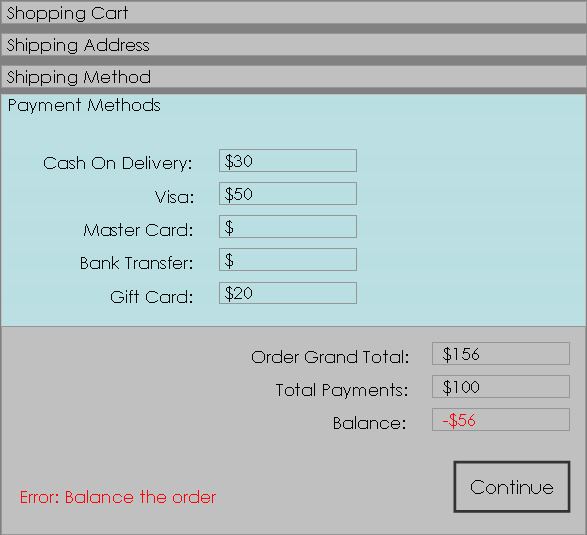 | ||
Split payment (a.k.a. Split payment transaction) is the financial term for the act of splitting (dividing) a single and full amount of payment in two or more simultaneous transactions made by different payment methods. For example: split payment of a $100 to a retail shop can be done when the customer pays $50 in cash and $50 by credit card. Split payment is not installment (a.k.a. Hire purchase), where payments are done periodically with the same payment method.
Contents
History
With the era of global trade, the financial possibilities grew and with them the challenges of collecting payments. The global markets made open and the consumer gained an increased buying power. In local and international transaction merchants are required to provide consumers with multiple payment options - this is not only a service required by consumers, it is a must-have for merchants in order to convert their products/services into cash. Statistically, the more payment options a merchant is able to offer, the likelihood of reaching more consumers increases. The various payment methods available world-wide is overwhelming, nevertheless the payment methods available in a specific market are influenced by the local laws, legislations, culture and level of development. For merchants this creates a challenge of adapting their systems to accept a wide range of payment methods in order to enter a market with their offerings.
Split payment vs. Coupon
There are few models for split payment, some use the term for coupons or vouchers, when used to subsidies part of the full amount of payment. While this approach can be used for simplifying the concept, it is yet not what is meant by split payment. The major difference between split payment and coupons is in that coupons are used to discount the full a new amount of payment - which is later paid in full by a single payment method in a single transaction. A significant difference between a split payment implementation and a coupon implementation is the stage at which they appear during the checkout process. A coupon is implemented before the payment process, also referred to as the shopping cart. The split payment is implemented during the process of the checkout, usually one of the lasts steps.
Business challenges
The challenges for the business are all across the organization. It is mainly the accumulation and the reference of two separate transactions into a single order. What is in real-life trivial (the two payments come from the same hand) is for business processes a great challenge, and it is a bigger challenge when these transactions made on the Internet. The business challenges shy both small and large merchants from offering split payment. Amazon mentions on their help pages that they do not allow split payments:
No, payment cannot be split between a checking account and a gift card or credit card.Technical challenges
The IT systems dealing with financial transactions process those transaction as atomic unit. Financial systems complete one transaction from beginning to end, a following transaction is therefore a totally new case. Combining the two transactions has impacts on costs, anti-fraud, reporting obligations (law & regulations) and might end up with partial information stored in the merchant system.
Point of Sale
In the offline business, Point of Sale (POS), split payment is already implemented.
